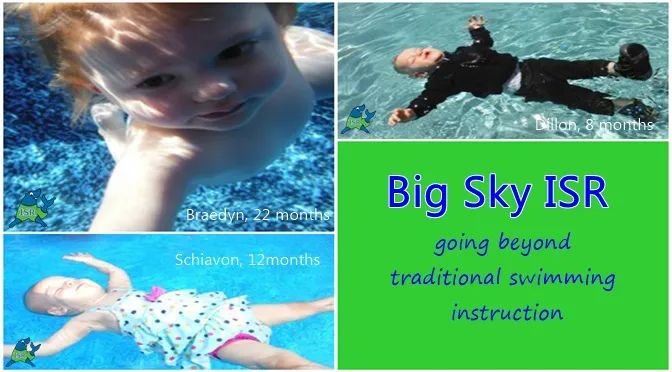
Big Sky ISR: Going Beyond Traditional Swim Instruction
June 2015
by rebecca stewart
Accidents happen – by their very nature we can’t plan for them, so doesn’t it make sense that we would want to provide our children the tools to successfully handle situations as they arise? In the June issue of Simply Family Magazine Big Sky ISR (Infant Swimming Resource) was “inthespotlight,” and as we settle into summer vacation and all kinds of water fun, we’re shining that light once again to give you an actual look (see video below) at what this type of lesson is all about and why it’s so important. In that original spotlight we shared with you what it is that makes ISR different from the traditional swim lesson. In preparing for that article I was able to observe a lesson with 19 month old Dillon. It was incredible to watch this little peanut jump eagerly into the water and get straight to the swim-float-swim survival sequence focused on with 1-6 year olds. But I’m getting ahead of myself. A quick refresher on what this whole ISR thing is all about…
Kayla Dorwart, owner and certified instructor of Big Sky ISR explained that ISR lessons differ from traditional swimming instruction in several ways. One, it teaches children ages 6 months-6 years old Self-Rescue™ techniques designed to help them survive should they ever find themselves in the water alone. Two, prior to diving into the ISR lessons parents complete a questionnaire that is evaluated by a staff of doctors and nurses, ensuring the safest lessons possible for each child. Having this detailed information allows for the instructor to “make each lesson the safest and most efficient lesson for each child,” noted Kayla. And as we mentioned in the article:
ISR Lessons are…
- One-on-one.
- Taught 10 minutes a day, five days a week for roughly 4-6 weeks. There is flexibility in the number of lessons, as it’s completely based off the pace of the child.
- Research shows that infants and young children retain virtually everything that happens in those 10 minutes – teaching in the 1:1 setting for short periods of time are the safest, most effective way of teaching survival swimming.
- Focused on teaching children 6-12 months old to roll onto their back to float, rest and breathe (utilizing gentle physical prompts), maintaining that lifesaving position until help arrives.
- Focused on teaching the swim-float-swim survival sequence for children 1-6 years old. They learn to swim with their faces in the water, and when they sense the need for air, they roll onto their back to float, rest and breathe; and roll back over to resume swimming until they reach the side of the pool or where they can crawl out or until they’re rescued.
Once the children are fully skilled they’ll practice the ISR survival techniques fully clothed because statistics show that most children (roughly 85%) who fall into water are fully clothed. Refresher lessons every 6 months-1 year are recommended, as “we need to adjust their skills with their growing bodies,” said Kayla.
Back to Dillon. We could spend all kinds of time talking about what it was like for me to watch this little one rocking the water, but wouldn’t you rather see for yourself? Following is a video of Dillon at 8 months old doing a rollback to float sequence.
Incredible, right?
No, we can’t plan for accidents and we all know things can change in the blink of an eye, so setting your kiddo up to be an “aquatic problem solver” might just be the perfect tool to add to the ol’ life toolbox.
To learn more about Big Sky ISR/ISR lessons: Contact Kayla at k.dorwart@infantswim.com or (406)860-1976.
